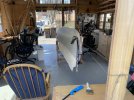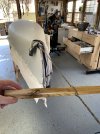Zenith
Curious about wooden canoes
ewitzel
I forgot to mention that as I pulled the canvas tight at the stems, I used a carpenters stapler to attach the canvas to the stem while I pulled it tight. This made it easy to get the canvas tight instead of trying to tack it while pulling on the pliers. It also allowed me to check the results before tacking. When I was done I tacked the canvas to the stem and removed the staples. It was a lot easier than I thought it would be.
John
I forgot to mention that as I pulled the canvas tight at the stems, I used a carpenters stapler to attach the canvas to the stem while I pulled it tight. This made it easy to get the canvas tight instead of trying to tack it while pulling on the pliers. It also allowed me to check the results before tacking. When I was done I tacked the canvas to the stem and removed the staples. It was a lot easier than I thought it would be.
John



